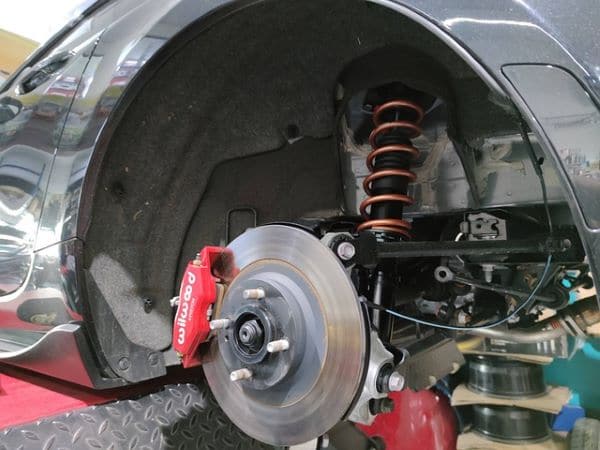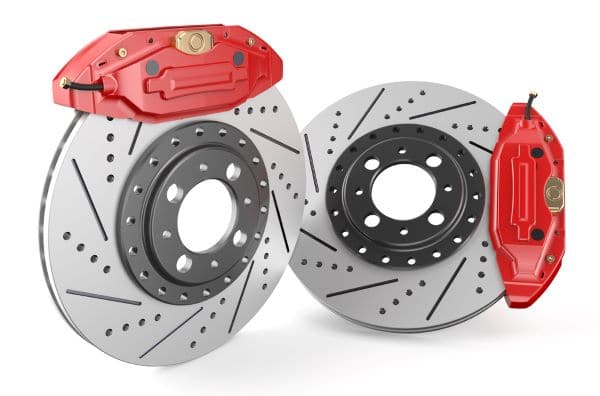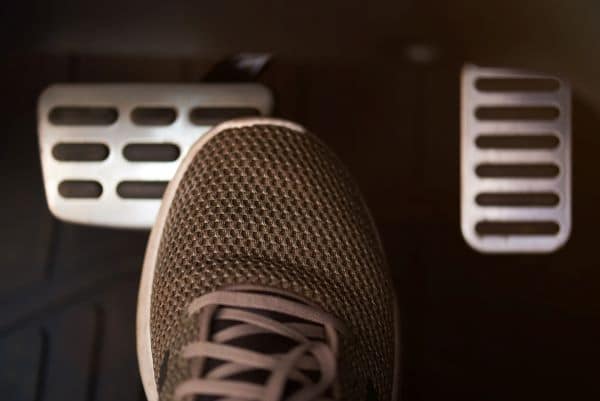Without adequate stopping power, you risk a serious accident while driving a vehicle with bad brakes. That’s why it’s important to know the average lifetime of brake rotors, so you can stay on top of your on-road safety.

In this article, we discuss how long do rotors last? In general, you should get the answer to how long do car brakes last after reading this article.
Table of Contents
What are Brake Rotors?
Before we answer how long do brake rotors last, it’s important to understand the braking system. Your vehicle is equipped with one of two systems, either drum or disc brakes.
The most common type is the disc brake system. In this configuration, you have a brake disc, known as the brake rotors, brake pads and a brake caliper. When you push down the brake pedal, the caliper forces the pads to squeeze into the rotor. The friction that is created from this movement is what helps you slow down and stop the vehicle.
While older vehicles are typically equipped with drum brakes, you can find some newer cars that have drum brakes on the rear with discs on the front. While they operate the same, there are no pads pushing into the rotor. Instead, brake shoes are used.
The disc brake system is more popular because it can absorb heat better while dissipating it evenly. However, the heat created by braking will eventually wear out the rotors, reducing braking ability.
Types of Brake Rotors
Understanding how the brake rotor works might lead you to believe that there’s nothing else to know, but that’s not true. In fact, there are many different kinds of brake rotors to familiarize yourself with, each lasting a different amount of time.

You will find these main types of brake rotors on the market:
- Smooth
- Drilled
- Slotted
- Slotted and Drilled
- Two-Pieces Floating
We will look at each a little more in-depth, describing the differences in the design.
Smooth
The smooth rotor is the most common type found, normally as part of the OEM equipment. This standard rotor is flat and looks like a disc. It’s a one-piece design that tends to work best in aggressive situations.
However, this brake rotor wears out the quickest because every part of it comes in contact with the brake pad when applied. The faster your vehicle is moving, the more wear that will occur. With that said, brake rotors still last longer than most brake pads, so that is a plus.
Drilled
The drilled rotor contains holes that prevent the build-up of heat. With this design, the gas can’t build up either during braking. Drilled brake rotors are best for wet conditions because the water can’t pool on the surface. Additionally, the water makes its way out of the rotors, making it easier to stop.
With a drilled rotor, you should notice less heat than a standard rotor, but these holes can affect how long they last due to lower strength. In fact, the drilled rotor is susceptible to cracking over time.
Slotted
The slotted rotor contains similar benefits to the drilled rotor. With the slots, there is less surface coming in contact with the pads when the pedal is pushed. With less heat build-up and by providing room for the dust to escape, the slotted rotor can work effectively.
Additionally, water passes over the rotor without creating a pooling effect. Unlike the drilled rotor, the slotted type remains intact as one piece of metal, adding some strength to the design. With this setup, there’s less chance of cracking, so it should last longer.
Slotted and Drilled
As a combination type, you get the best of the drilled and slotted designs. You get maximum heat dissipation benefits with more strength. However, you will typically spend more on this type of rotor because of how much harder they are to produce.
Two-Pieces Floating
The final design worth looking at is the two-piece floating rotor. With the two-piece construction, heat is reduced because the rotor gives a little with the brake pad. You will get the best results from these in hotter conditions where the rotor needs to expand for fast stopping, but it doesn’t operate as well in the cold.
Additionally, salt can cause trouble if it gets between the two pieces. In extreme cases, it leads to damage that can prevent you from stopping.
How Long Do Rotors Last?
Maybe the right question should be how long should brake rotors last because the factors that affect their lifespan can range greatly. How you drive, the size of your vehicle and the quality of brakes that you purchase all have an impact on how long the rotors will survive.
With that said, most brake rotors will operate normally for up to 70,000 miles. However, the style of your driving and the type you purchase could lessen driving time to 30,000 miles. The best way to ensure that the rotors can be changed when they should is to inspect them often.
Symptoms of Bad Brake Rotors
If you notice any of the following symptoms, there might be something wrong with your brake rotors. You should have them inspected immediately before you have trouble stopping your vehicle.

Squealing
If you notice a high-pitched squealing or screeching when you step on the brakes, it’s an indication that the brake pads are wearing down. When this happens, damage to your brake rotors can occur as metal starts rubbing against metal.
Grinding
When you ignore the first sign that your brake pads are worn, you will begin to hear a grinding noise. This happens when all of the brake pad material is worn away, leaving only the metal plate behind. If you continue to drive your vehicle like this, you are causing major damage.
Vibrations
When you push the brake pedal down, you should come to a smooth stop. If the brake pedal begins pulsating or you feel vibrations in the steering wheel, there’s a chance that you are dealing with a worn-out or warped brake rotor. The car should never shake while braking under normal conditions.
How to Check Rotors
If you have been out on the road and noticed any of these symptoms, it’s time to check the brake rotors for wear. You should never wait to investigate the problem as it will only lead to large brake repairs down the road, as well as compromised safety.
Thankfully, you don’t need a lot of mechanical knowledge or expensive tools to inspect the rotors.
- Park on flat ground and set your emergency brake. You will want to inspect all of the brake rotors on the driver and passenger sides, as well as front and back.
- Use your lug wrench to loosen up the lug nuts on the wheel you are starting with. Do not remove the lug nuts yet.
- Place your floor jack under the vehicle and lift that tire off the ground about an inch.
- Take the lug nuts off and remove the tire.
- If you notice a dirty or dusty rotor, you might need to spray it with some brake cleaner.
- Place a straight ruler against the brake rotor’s surface. There should be no space between the two. If you see any gaps, the rotor is warped and needs to be dealt with right away.
Here are some tips from a popular YouTube video if you need more direction.
How Often to Replace Brake Rotors vs. Resurfacing
Now that you understand the answer to “how long do rotors last,” it’s important you know what to do once they wear out or warp. Your two main options come down to replacing the rotors or resurfacing them. There are pros and cons to both decisions, requiring us to look a little closer.
If the rotor is in decent condition, you might be able to resurface it and get a little more life out of it. Resurfacing brake rotors is also referred to as machining or turning the rotors. This process requires a technician to grind down the metal until it is even and smooth again.
While it is the cheaper option, it only works with rotors that are not badly warped and still have a decent amount of thickness. You can’t resurface rotors that are grooved, cracked, heavily rusted or majorly warped. You also don’t want to take the rotor thinner than what the manufacturer recommends.
If you can’t have the rotors resurfaced, you will be forced to replace them instead. Plus, resurfacing the rotors only fixes the problems temporarily. You will still have to replace the rotors at a later time.
Tips to Extend Lifetime of Brake Rotors
You can make your brake rotors last longer simply by making a few changes. If you don’t want to resurface or replace the rotors often, consider these helpful tips.

Change Your Driving Style
The rotors are going to wear down faster if you are hard on your brakes. Whether you are constantly making hard stops or you ride the brakes, you are causing the pads and rotors to wear down faster than necessary.
If you are gentle on the brakes, you can add many miles to the lifespan. Here are a few tips you can implement right away.
- Always drive the speed limit or slower
- Coast whenever possible
- Pay attention to traffic ahead and let off the accelerator when you might need to slow down
- Maintain safe driving distances
Consider the Driving Conditions
If you regularly commute in stop-and-go traffic conditions, you are putting more wear on the rotors. The brake pads are also going to wear down faster than normal. If possible, consider changing the drive to include more freeway miles, even if it adds a couple of minutes to the commute.
You can also stop braking so much by implementing more coasting. The less often you have to brake, the longer the rotors will last.
In the same respect, if you spend a lot of time driving on mountainous or windy roads, you are probably using your brakes more often. To help prolong the life of the braking system, you might consider implementing more engine braking by downshifting, especially when going downhill. Not only will this prolong the life of the brakes, but it keeps them from fading because of excessive heat.
Reduce the Load
The more weight that is in your vehicle, the harder the brakes need to work to stop it. To avoid wearing out the brakes prematurely, consider lightening the load a little. If you drive a truck, take cargo out of the bed when you are done with it. Alternatively, cars and SUVs can also haul a lot in the trunk and passenger space. Take inventory of what you actually need with you every day and remove everything else. You might also notice better fuel economy, which is just another bonus.
Maintain the Tires
Your tires play a big role in how well the braking system works. Both need to be in optimal health to stop your vehicle. If one isn’t working right, the other will suffer.
Tires with decreased tread depth take longer to stop, forcing your brakes to work harder. If your tires have less than 4/32” of tread depth, it’s time to replace them. Additionally, you should regularly check the tire pressures to ensure they are riding the way they should. You can find the optimal tire pressure on the card found inside the driver’s door jamb.
Replace the Brake Pads
The brake pads are responsible for working with the rotors to stop the vehicle. Every time you push the brake pedal, the pads make contact with the rotor to stop the tires from spinning. Your brake pads will last between 20,000 and 70,000 miles, depending on what type you purchase and how you drive.
At the first sign that the pads are worn, you should replace them. If you allow all of the brake pad material to wear away, you will create damage to the rotors. The metal of the pads starts to wear against the rotors, not only ruining this vital brake part but also compromising your on-road safety.
It can also lead to other damage, whether to your brake caliper or lines. Trust us; you don’t want to deal with more expensive brake repairs or require the need for a brake line flaring tool. You can change the brake pads for far less money than doing extensive repairs.
Brakes FAQs
How many rotors does a car have?
Your car probably has four brake rotors, one for each wheel. The brake pads squeeze against the brake rotor to stop the wheel from spinning, bringing your vehicle to a stop or slowing it down.
How long do brake pads and rotors last?
Brake pads don’t normally last as long as the rotors, with the average lifespan ranging from 20,000 to 70,000 miles. On the other hand, brake rotors can average about 70,000 miles when properly taken care of, but that might mean some resurfacing when you change your brake pads.
How long do brake calipers last?
The brake calipers aren’t designed to break down often. However, there are times when you might need to replace the calipers, normally after at least 75,000 to 100,000 miles.
How long do brake drums last?
Drum brakes rarely go bad, sometimes lasting 200,000 miles or more. In fact, it’s not unusual to see factory drum brakes on a car that has driven hundreds of thousands of miles. If you want to know how long do drum brakes last, it’s best to have a mechanic measure them to see how much life is left.
How long can you drive with bad rotors?
You should never drive on bad rotors. Your brakes convert kinetic energy into heat because of the friction. This is needed to slow down and stop your vehicle. For every mile you drive on bad rotors, you put your life at risk. In extreme conditions, the rotor can be worn right down to the cooling fins, leaving behind no surface to slow the vehicle. This condition will cause the caliper pistons to over-extend, leading to even more failure. Eventually, the vehicle won’t stop and you will be in a dangerous situation.
Conclusion
How long do rotors last? As we have discussed, there are many factors that play into the rotor’s lifespan, but you can count on around 70,000 miles if you take care of it. With our guidelines, you can ensure the rotors last as long as possible, ensuring you are safely brought to a stop every time you step on the brake pedal.
